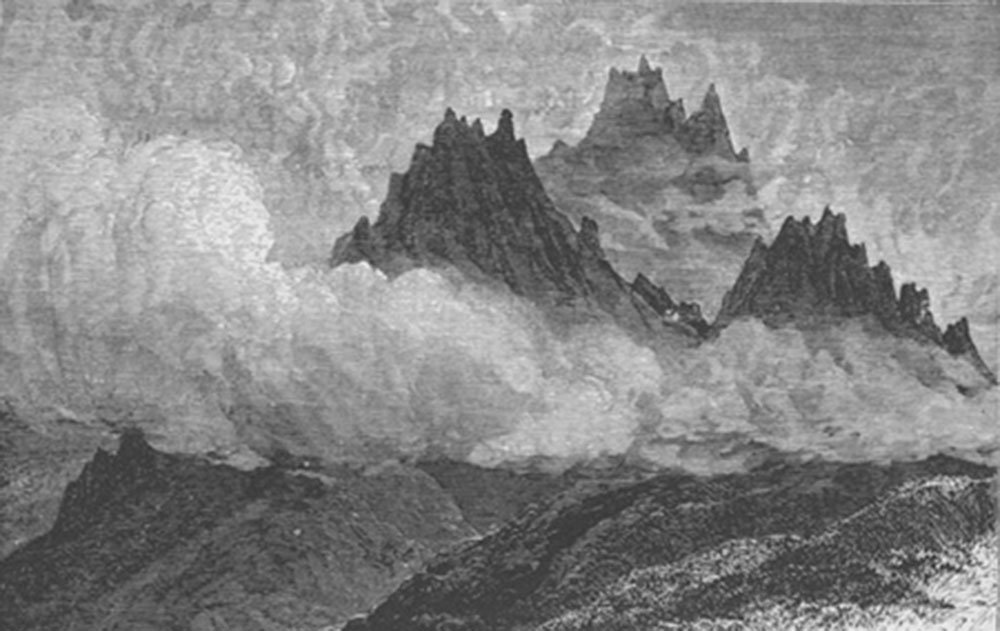Glengariff - Irish Pictures (1888)
From Irish Pictures Drawn with Pen and Pencil (1888) by Richard Lovett
Chapter V: Glengariff, Killarney, and Valentia … continued
« Previous Page | Start of Chapter | Book Contents | Next Page »
Eloquent descriptions of Glengariff abound, sometimes accurate and adequate, sometimes charged with a pardonable exaggeration. But the perusal of these tends to form either untrue or disproportionate ideas of this celebrated glen. Perhaps the ideal course would be to go and see the spot, and then read the descriptions. Glengariff is emphatically a place where the eye sees what it is capable of seeing, and the impression received will vary here, more than in most places, according to the brain to which the eye transmits its sensations. Those who love the combination of bold rocks with lovely dells whose sides are fringed with beautiful trees, and through which musically murmuring streams run down to the sea; those who rejoice in the fresh, blue, health-giving ocean, and who yet love to look upon it in its gentler and softer moods; those who like when taking a holiday to exchange the rush and struggle and selfishness of modern metropolitan life for the peaceful country, far removed from the roar of business and the fierceness of modern competition, and yet sufficiently in touch with the outer world to avoid all traces of stagnation—such as these can hardly do better than select Glengariff as a place of resort. The modern tourist loves his comforts, and these he can have in the hotels. Be he pedestrian, or cyclist, or fisherman, or sketcher, or lover of boating and driving, here can he indulge to the full his favourite recreation. And he can at the same time breathe some of the purest air and rejoice in the marvellous wealth of rich and lovely scenery with which the beneficent Creator has gladdened this part of the land.
The name Glengariff means 'the rugged glen.' It includes the harbour formed by the innermost recess of Bantry Bay, and the valley through which flows the Glengariff River, in its descent from Eagle's Nest Mountain, to the sea. The bay is dotted with a large number of tiny islets; the river rushes headlong down from its source, reaching its highest point of beauty, perhaps, at the old ruined arches of what is known as Cromwell's Bridge. The temperature in this favoured glen varies . within narrow limits, the vegetation is rich, the arbutus, the rowan-tree, the holly, azaleas, rhododendrons, and hydrangeas, all flourish here, and its wonderful combination of beauties and advantages make it a notable place of rest for the overworked and weary, and a choice wintering place for the delicate.
But most who visit this earthly Paradise, like ourselves, however fain to linger, have to hasten on to other scenes. There is a road from Glengariff to Gougane Barra, and thence to Killarney; but the vast majority go by the main road to Kenmare. This is as fine a drive as any tourist need wish to enjoy. The road runs through the village, and then for a short distance along the left bank of the Glengariff River, and finally begins to wind ever higher and higher up the valley of a small tributary of the Glengariff River, which it finally crosses, and winds around a bold, steep hill at a height of nearly 800 feet above the sea. From this point a comprehensive view of the greater part of Bantry Bay is obtained. It then turns sharply to the north, rising still higher and penetrating into ever wilder mountain scenery, until a peak known as Turner's Rock, over 1,300 feet above the sea, is reached. This is pierced by a fine tunnel, and as the car passes out of the long and somewhat gloomy passage a superb view greets him. Stretched out before him, but mainly to his left hand, are the fine multitudinous peaks of Ireland's greatest mountain chain, the McGillicuddy Reeks. Seen early in the year, say in April, they are often covered with snow, and present a most beautiful appearance. Seen under any circumstances with the essential element of a tolerably clear atmosphere, their wild forms, their great extent, their fine configurations rejoice the heart within the lover of natural beauty. The road climbs for a time along the steep side of one of these huge mountain masses, and gradually descends, crosses the river, and finally runs for miles along the left bank of the Sheen. The scenery gets softer as one approaches Kenmare. The Sheen finally empties into the Sound, the inner part of Kenmare Bay, and, about a mile below the mouth of the Sheen, a fine suspension bridge has been thrown across Kenmare Bay, over which passes the road.
Kenmare is quite a recent town compared with some of its neighbours, having been founded as a colony in 1670 by Sir William Petty, the ancestor of the present Lansdowne family. There is little in it to detain the visitor, unless he intends to explore the fine mountainous country round about, in which case it becomes a very convenient headquarters. For most the hour or two of waiting for the mail-cart, or securing a fresh horse and car, is sufficient; and after a brief stay the journey to Killarney is begun.
« Previous Page | Start of Chapter | Book Contents | Next Page »

